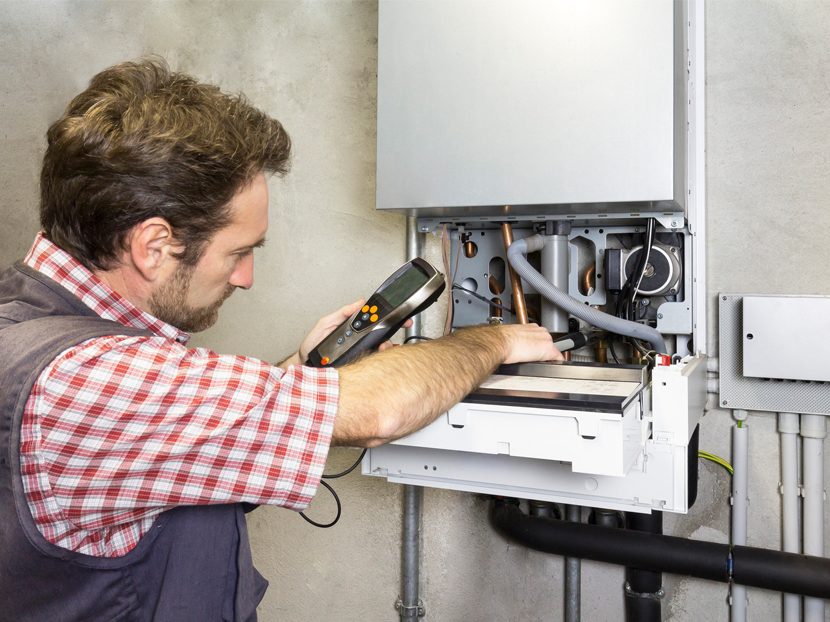Fire and Flow, Part 2
Be aware of what is going on with gas-burning equipment to keep yourself and your customers safe.

“Next month, I’ll break out some more bullet points and we’ll dig into the other critical ingredient of a successful hot water space-heating system — fire.” That’s what I said, so that’s exactly my plan of attack today. Let’s get to it. I’ve had my eyebrows scorched from a late light-off. Now, I always have one hand on the disconnect switch when I’m firing one up with a possible delayed ignition.
I’ve seen rooftop unit panels blown across a roof from delayed ignition. I’ve seen a burner mounted sideways, and firing, on a manifold — that’s how fires start.
I’ve seen a hole in a heat exchanger so big I could put my fist through it. And this was one day after another company did maintenance on it. All I had to do was pull the rollout shield. It was right there and impossible to miss.
I’ve seen a steam boiler side panel glowing cherry red. I’ve seen flame rollout so bad that every wire in the boiler vestibule was burnt to a crisp. I’ve seen every limit switch, rollout switch and fusible link known to man jumped out. Don’t do that. Ever.
I’ve cleaned enough soot-filled boilers and furnaces that I’m perfectly content never to clean one again. And unless it’s my own or my daughters’ equipment, I won’t.
I’ve seen a lot, and there’s more, but I think you get the point: There are more ways to have a screwup with a gas-fired appliance than there are words in this column.
The moment I walk into a boiler room, my eyes and ears and nose are on high alert. If the burner(s) is lighting rough, I want to hear it. If the flame is rolling out, I want to see it. If something is burning slightly, I want to smell it.
And If I smell natural gas and something slightly burning at the same time, I’m reaching for the service disconnect switch and gas shutoff right then.
Your senses as tools
Don’t discount some of your most valuable tools: your eyes, ears and nose. The more experience you add to your resumé, the better tuned your senses become.
Yes, the customer is likely to be shadowing you and telling you how he has been timing the gaps between the loud booms for the past 23 1/2 hours. The information is important, but you have to be a selective listener to a degree. Listen for the keywords and lock in on them.
At first, you need to focus on what you’re seeing, hearing and smelling. After that, it’s time to break out the tools and test instruments. And if you’re anything like me, this is what it’s all about anyway. We love using our tools; we love buying them even more.
It’s the best part of the job, after depositing the checks — using the JB gas pressure gauge, Testo 320 analyzer, digital thermometers, UEI gas sniffer, Fluke multimeter and the assortment of Klein, Wera, Knipex, GearWrench, Craftsman, Wiha and Stanley hand tools is why we’re doing this, right? Right! We can justify the purchase of almost any tool on planet Earth to our significant others as being part of why we are the incredible technicians we are. So, if we’re going to buy them, let’s use them.
I like to address the things that are blatantly wrong right off the bat. Pull and clean the burners, make sure the burners are aligned correctly, repair burned wiring and secure them away from the heat, make sure the rollout shield is secured in place, check for and fix gas leaks, look for signs of flue gas spillage, check the integrity and pitch of flue pipe.
Many of these things would fall under the category of checklist-type items. The rubber doesn’t hit the road until we start using the test instruments, recording values and making adjustments if needed. This is usually what separates the heavyweight techs from the rippers and runners.
And the difference can be boiled to just a few things — knowledge, the desire for more knowledge, personal integrity and taking pride in a job done well.
As I did last month, I’m going to hit on some of the most important things to know by way of one of my favorite tools, the bullet point. It’s not as if I’m making a mixed tape for you. I want you to get the goods in a clear, concise way. Here goes:
Typical troubleshooting and maintenance testing
- Verify the voltage and polarity.
- Checking the gas pressure is a critical step for so many reasons (Figure 1); check with the manufacturers’ specifications if you don’t know what they require. Sometimes the required gas pressure is higher than you might think; some gas-fired infrared heaters come to mind, for example.
- Safety, compliance, consistency and efficiency are some pretty solid reasons to complete a combustion analysis. It will give an accurate representation of how the burner is firing. Tune it, if necessary, to the manufacturer’s recommendations. Leave a copy of the printed results with your customer.
- Clocking the gas meter with this checklist:
- 1. Turn off all appliances except for the one you’re testing.
- 2. Make sure the one you’re checking is firing.
- 3. For residential work, the 1/2 cubic feet gas dial works fine. This means for every revolution, 0.5 cubic feet of gas is burned.
- 4. Time the dial for exactly one minute and count the number of revolutions.
- 5. Take a look at this example. There are 2.2 revolutions in one minute.
- 2.2 x 0.5 = 1.1 cubic feet/minute
- 1.1 x 60 = 66 cubic feet of gas
- 66 x 1,038 = 68,508 BTU/hour input
- (1,038 equals the BTU/hour/cubic feet as verified on my gas bill.)
Properties of gas
- Unlike LP gas, it’s lighter than air. The engineers assign a value to it called specific gravity. Air has a specific gravity of 1. How convenient! Anything less than 1 is lighter than air. Anything greater than 1 is heavier than air.
- The specific gravity of natural gas is 0.6 and lighter than air.
- The specific gravity of propane gas is about 1.5 and heavier than air.
- The heat content of natural gas ranges from 950 to 1,125 BTU/hour/cubic feet. An estimation of 1,000 BTU/hour/cubic feet will get you close. For precise numbers, check with your utility or your utility bill to confirm exactly what yours is.
- The heat content of propane gas is approximately 2,500 BTU/hour/cubic feet.
- Natural gas ignites between 1,100-1,200 degrees.
- Propane gas ignites between 920-1,020 degrees.
- Both are extremely dangerous, but propane is more likely to linger because of its weight (specific gravity) and lights off quicker.
So many efficiencies
Combustion efficiency: The ability of the boiler to convert fuel to heat energy. It’s based on a theoretical heat value because, as I mentioned previously, the value varies based on your local utility.
Steady-state efficiency: Combustion efficiency when the flue gas temperature has stabilized (stopped rising) and the flue gas samples level off.
Annual fuel utilization efficiency: This is the one we use to sell equipment, but it won’t be accurate with a poorly designed system. It’s a seasonal average, expressed in percentages, required by the Federal Trade Commission. It considers the cycling losses, chimney losses and jacket losses.
Thermal efficiency: The rate at which the heat exchanger transfers heat to the medium, usually water or air.
Burner problems
An infinite amount of information can be learned regarding the servicing and troubleshooting of gas-fired burners. There are entire chapters and entire books dedicated to these topics. I’m going touch on a few of the problems you may encounter during the course of a service schedule:
Overfired: Check gas pressure, firing rate and delta T. This can lead to short cycling, early control, equipment failure, soot, inefficiency and a host of other issues.
Underfired: Check gas pressure, firing rate and delta T. Some of the symptoms of an underfired burner are inadequate heat, flue gas condensation (which isn’t good for a lot of equipment), inefficiency and shortened equipment life.
Delayed ignition: This can be caused by dirty burners, dirty burner crossovers, low gas pressure, and misaligned burners.
Floating flame and flame rollout: Most of the time this is caused by plugged-up boiler sections/heat exchanger, or a crack or hole in the heat exchanger. Soot, not enough secondary air and an improper burn are usually the culprits.
Yellow tipping: This is caused by flame impingement or incomplete combustion; the latter being too much gas or too little primary air.
Lifting flame: Just as it says, the flame is lifting above the burner. Too much primary is the cause.
There’s more
Be aware: Make sure the boiler room has a properly sized air source for combustion. In commercial rooms, my preference is always a motorized damper with an end switch.
Don’t assume: I’ve had two different jobs in the past year where the cause of the problem was grossly oversized orifices on commercial power burners.
Don’t jump out: Don’t ever jump out any type of safety control and walk away from the equipment. There’s never a good enough reason to put property or people in harm’s way.
Be thorough: Nobody likes callbacks, especially your boss, supervisor and customer.
Be safe: My singed eyebrows recovered but it could have, and should have, been avoided. Think it through, double-check your work and verify with testing, not guessing. And wear a low-level carbon monoxide sensor (Figure 2) on your person when you’re on the job.





